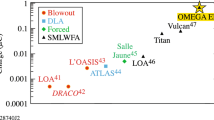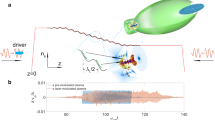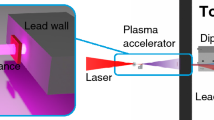Abstract
High-power lasers that fit into a university-scale laboratory1 can now reach focused intensities of more than 1019 W cm-2 at high repetition rates. Such lasers are capable of producing beams of energetic electrons2,3,4,5,6,7,8,9,10,11, protons12 and γ-rays13. Relativistic electrons are generated through the breaking9,10,14 of large-amplitude relativistic plasma waves created in the wake of the laser pulse as it propagates through a plasma, or through a direct interaction between the laser field and the electrons in the plasma15. However, the electron beams produced from previous laser–plasma experiments have a large energy spread6,7,9,14, limiting their use for potential applications. Here we report high-resolution energy measurements of the electron beams produced from intense laser–plasma interactions, showing that—under particular plasma conditions—it is possible to generate beams of relativistic electrons with low divergence and a small energy spread (less than three per cent). The monoenergetic features were observed in the electron energy spectrum for plasma densities just above a threshold required for breaking of the plasma wave. These features were observed consistently in the electron spectrum, although the energy of the beam was observed to vary from shot to shot. If the issue of energy reproducibility can be addressed, it should be possible to generate ultrashort monoenergetic electron bunches of tunable energy, holding great promise for the future development of ‘table-top’ particle accelerators.
This is a preview of subscription content, access via your institution
Access options
Subscribe to this journal
Receive 51 print issues and online access
$199.00 per year
only $3.90 per issue
Buy this article
- Purchase on Springer Link
- Instant access to full article PDF
Prices may be subject to local taxes which are calculated during checkout





Similar content being viewed by others
References
Perry, M. D. & Mourou, G. Terawatt to petawatt subpicosecond lasers. Science 264, 917–924 (1994)
Key, M. H. et al. Hot electron production and heating by hot electrons in fast ignitor research. Phys. Plasmas 5, 1966–1972 (1998)
Tajima, T. & Dawson, J. Laser electron accelerator. Phys. Rev. Lett. 43, 267–270 (1979)
Joshi, C. & Katsouleas, T. Plasma accelerators at the energy frontier and on tabletops. Phys. Today 56, 47–53 (2003)
Esarey, E., Sprangle, P., Krall, J. & Ting, A. Overview of plasma-based accelerator concepts. IEEE Trans. Plasma Sci. 24, 252–288 (1996)
Wagner, R., Chen, S. Y., Maksimchuk, A. & Umstadter, D. Electron acceleration by a laser wakefield in a relativistically self-guided channel. Phys. Rev. Lett. 78, 3125–3128 (1997)
Ting, A. et al. Plasma wakefield generation and electron acceleration in a self-modulated laser wakefield accelerator experiment. Phys. Plasmas 4, 1889–1899 (1997)
Tzeng, K. C. & Mori, W. B. Suppression of electron ponderomotive blowout and relativistic self-focusing by the occurrence of Raman scattering and plasma heating. Phys. Rev. Lett. 81, 104–107 (1998)
Modena, A. et al. Electron acceleration from the breaking of relativistic plasma waves. Nature 377, 606–608 (1995)
Santala, M. I. K. et al. Observation of a hot high-current electron beam from a self-modulated laser wakefield accelerator. Phys. Rev. Lett. 86, 1227–1230 (2001)
Pukhov, A. & Meyer-ter-Vehn, J. Laser wake field acceleration: the highly non-linear broken-wave regime. Appl. Phys. B 74, 355–361 (2002)
Clark, E. L. et al. Measurements of energetic proton transport through magnetized plasma from intense laser interactions with solids. Phys. Rev. Lett. 84, 670–673 (2000)
Edwards, R. D. et al. Characterization of a gamma-ray source based on a laser-plasma accelerator with applications to radiography. Appl. Phys. Lett. 80, 2129–2131 (2002)
Malka, V. et al. Electron acceleration by a wake field forced by an intense ultrashort laser pulse. Science 298, 1596–1600 (2002)
Pukhov, A., Sheng, Z. M. & Meyer-ter-Vehn, J. Particle acceleration in relativistic laser channels. Phys. Plasmas 6, 2847–2854 (1999)
Mangles, S. P. D. et al. Electron acceleration to 350 MeV due to the direct interaction of an ultra-intense laser pulse with an underdense plasma. Phys. Rev. Lett. (submitted)
Umstadter, D. Review of physics and applications of relativistic plasmas driven by ultra-intense lasers. Phys. Plasmas 8, 1774–1785 (2001)
Umstadter, D., Kim, J. K. & Dodd, E. Laser injection of ultrashort electron pulses into wakefield plasma waves. Phys. Rev. Lett. 76, 2073–2076 (1996)
Amiranoff, F. et al. Observation of laser wakefield acceleration of electrons. Phys. Rev. Lett. 81, 995–998 (1998)
Sprangle, P., Esarey, E. & Ting, A. Nonlinear interaction of intense laser pulses in plasmas. Phys. Rev. A 41, 4463–4467 (1990)
Bulanov, S. V., Kirsanov, V. I. & Sakharov, A. S. Excitation of ultrarelativistic plasma waves by pulse of electromagnetic radiation. JETP Lett. 50, 198–201 (1989)
Berezhiani, V. I. & Murusidze, I. G. Relativistic wake-field generation by an intense laser-pulse in a plasma. Phys. Lett. A 148, 338–340 (1990)
Sprangle, P., Esarey, E., Ting, A. & Joyce, G. Laser wakefield acceleration and relativistic optical guiding. Appl. Phys. Lett. 53, 2146–2148 (1988)
Akhiezer, A. I. & Polovin, R. V. Theory of wave motion of an electron plasma. JETP 3, 696–705 (1956)
Fonseca, R. A. et al. Lecture Notes in Computer Science Vol. 2329, III-342 (Springer, Heidelberg, 2002)
Faure, J. et al. Effects of pulse duration on self-focusing of ultra-short lasers in underdense plasmas. Phys. Plasmas 9, 756–759 (2002)
Acknowledgements
This work was supported by the UK EPSRC and RCUK. We thank the OSIRIS consortium (UCLA/IST Lisboa/USC) for the use of OSIRIS, and S. Karsch for discussions.
Author information
Authors and Affiliations
Corresponding author
Ethics declarations
Competing interests
The authors declare that they have no competing financial interests.
Rights and permissions
About this article
Cite this article
Mangles, S., Murphy, C., Najmudin, Z. et al. Monoenergetic beams of relativistic electrons from intense laser–plasma interactions. Nature 431, 535–538 (2004). https://doi.org/10.1038/nature02939
Received:
Accepted:
Issue Date:
DOI: https://doi.org/10.1038/nature02939
This article is cited by
-
Electro-optic 3D snapshot of a laser wakefield accelerated kilo-ampere electron bunch
Light: Science & Applications (2024)
-
Shaped liquid drops generate MeV temperature electron beams with millijoule class laser
Communications Physics (2024)
-
Efficient plasma electron accelerator driven by linearly chirped multi-10-TW laser pulses
Scientific Reports (2023)
-
Laser-driven low energy electron beams for single-shot ultra-fast probing of meso-scale materials and warm dense matter
Scientific Reports (2023)
-
Unveiling the inner structure of electron pulses generated from a laser-wakefield accelerator
Light: Science & Applications (2023)
Comments
By submitting a comment you agree to abide by our Terms and Community Guidelines. If you find something abusive or that does not comply with our terms or guidelines please flag it as inappropriate.



